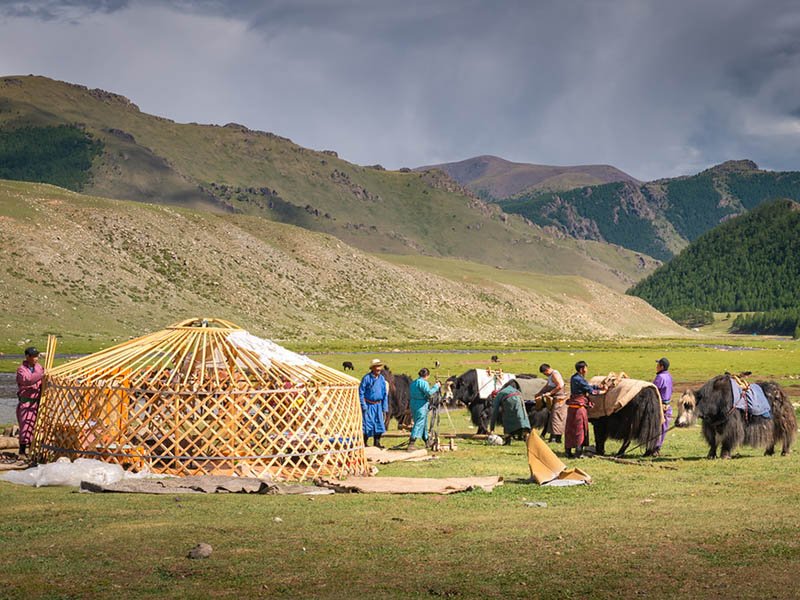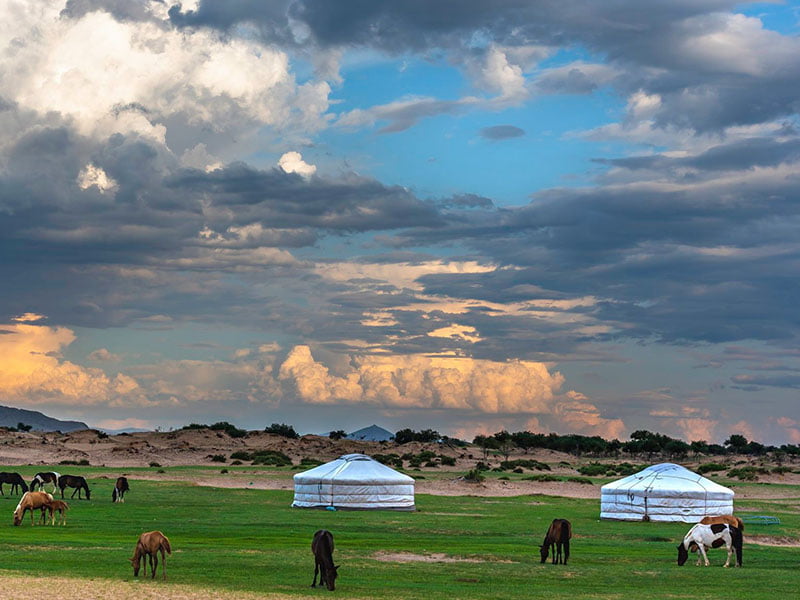A yurt is a round-shaped portable home that originated from nomads in Mongolia and other parts of Central Asia. In Mongolia, the yurt is called “ger” [gher]. The terms “yurt” and “ger” are interchangeable and describe the traditional portable Mongolian habitation consisting of a wooden frame and felt walls. Yurts (gers) are designed to be easy to take apart, transport, and reconstruct. Despite this portability, they are warm enough to keep the coldest winter temperatures at bay and strong enough to withstand strong winds and the demands of a whole family.

The yurt (ger) is built using a wooden, accordion frame that can be easily taken down, made compact for carrying, and reassembled. On this frame are placed two to three layers of felt, traditionally made from sheep’s wool, and an outer layer of waterproof canvas. The felt and canvas are secured to the wooden frame and the resulting structure can stand securely in one place for months or even years at a time.
The wooden frame of the yurt (ger) is held together by opposing stresses designed into the structure and by horse, yak and camel hair straps. A central column holds up the struts of the roof, which fan out from an opening that accommodates a stove pipe and can be opened up to the elements on a warm day or covered in the event of rain or cold temperatures. The lower sides of the outer wrapping of the yurt can also be raised to allow air to circulate freely to cool the interior on warm days. Please check this page to see components of the yurt.


Although nomads in Mongolia use yurts all year round in temperatures as low as -35 and as high as +40 degrees Celsius, we recommend using yurts (gers) in temperatures between about -20 and +30 degrees Celsius as it takes special care and expertise to keep the interior of a yurt warm during conditions colder than -20 degrees Celsius.
A yurt provides not only the atmosphere of a nomadic lifestyle but has many practical and enjoyable uses for people in around the World.
A Mongolian ger (yurt) makes an ideal second or holiday home in part because it can be put to many uses. One of practical ways to make use of a yurt is as a pavilion in a backyard or another spot. The ease with which air circulates through a yurt makes it cool in summer and it can also be made warm when the temperatures begin to fall. You can use a smaller yurt as a bedroom and view the stars in the night sky through the opening in the roof. A yurt can just as easily be used as a kitchen or dining room or a combination of the two; you could even try cooking Mongolian-style barbecue in your Mongolian ger. A yurt can be used as a dining pavilion, a marquee for a family event, or as a playhouse for children. We recommend our paint-decorated or carved yurts with 5 or 6 wall panels for these kinds of uses.
Yurts can be put to use as the site of a small business or a classroom for seminars and workshops. Yurts are environmentally friendly structures and are perfect for use as temporary housing, glamping, a small shop, a festival structure, a guest house, or a holiday home. For this type of use we recommend our paint-decorated or carved yurts 6, 7, 8 and 10 wall panels.
A Mongolian yurt (ger) can also be used to provide space for a variety of activities for companies offering recreational services, and they will be a point of interest for patrons. As you may have seen in Mongolia, yurts are commonly used to provide bungalow-type accommodation at tourist camps in the countryside. Yurts are used not only as accommodation but also as restaurants, shops and museums in the land of their origin. If you are interested in using a yurt for a business such as pub and restaurant, we recommend yurts with 10 wall panels or larger. An original Mongolian yurt with ten wall panels will contain approximately 20 restaurant tables with five seats each.
In modern days, there are two main types of yurts. First type includes essentially the same yurt that have been used by Mongolian nomads thousands of years. These traditional yurts are portable, eco-friendly (with zero foot print on earth) and made of mostly natural products such as wood, sheep wool felt and cotton. Traditional Mongolian yurts have lots of characters, and are great for anyone who wants to feel closer to mother Earth. We at Original Yurts are make and worldwide supplier of these traditional yurts with various modifications made to improve functionality and durability of the yurts in non-Mongolian climate.
Second type includes so called modern yurts, which are produced mainly by companies in the U.S. The modern yurts take the concept of yurt structure from Mongolian yurts. But they are very different from traditional Mongolian yurts in other aspects. They are hardly portable, use lots of synthetics, and has the feeling of “manufactured”, product. See here more comparisons of Mongolian and modern yurts.